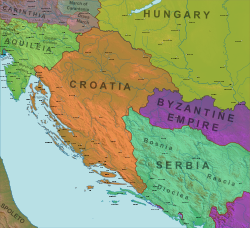Our website is made possible by displaying online advertisements to our visitors.
Please consider supporting us by disabling your ad blocker.
Duklja
Kingdom of Duklja | |||||||||
|---|---|---|---|---|---|---|---|---|---|
| 10th century–1186 | |||||||||
 Kingdom of Duklja (Dioclea) in 1089 | |||||||||
| Capital | Bar Shkodër | ||||||||
| Common languages | Old Serbian | ||||||||
| Religion | Christianity | ||||||||
| Government | Monarchy | ||||||||
| Prince/King | |||||||||
• 10th century | Petar (first known) | ||||||||
• 1046 – 1081 | Mihailo I (first king) | ||||||||
• fl. 1180 – 1186 | Mihailo III (last independent) | ||||||||
| History | |||||||||
• Established | 10th century | ||||||||
| 1077 | |||||||||
| 1186 | |||||||||
| |||||||||
| Today part of | Albania Bosnia and Herzegovina Croatia Montenegro Serbia | ||||||||
Duklja (Serbian Cyrillic: Дукља; Greek: Διόκλεια, romanized: Diokleia; Latin: Dioclea) was a medieval South Slavic state which roughly encompassed the territories of modern-day southeastern Montenegro, from the Bay of Kotor in the west to the Bojana river in the east, and to the sources of the Zeta and Morača rivers in the north. First mentioned in 10th– and 11th-century Byzantine chronicles, it was a vassal of the Bulgarian Empire between 997 and 1018,[1] and then of the Byzantine Empire until it became independent in 1040 under Stefan Vojislav (fl. 1034–43) who rose up and managed to take over territories of the earlier Serbian Principality, founding the Vojislavljević dynasty. Between 1043 and 1080, under Mihailo Vojislavljević (r. 1050–81), and his son, Constantine Bodin (r. 1081–1101), Duklja saw its apogee. Mihailo was given the nominal title King of Slavs by the Pope after having left the Byzantine camp and supported an uprising in the Balkans, in which his son Bodin played a central part. Having incorporated the Serbian hinterland (known as Grand Principality of Serbia, and anachronistically as Raška) and installed vassal rulers there, this maritime principality emerged as the most powerful Serb polity, seen in the titles used by its rulers ("Prince of Serbia", "of Serbs"). However, its rise was short-lived, as Bodin was defeated by the Byzantines and imprisoned; pushed to the background, his relative and vassal Vukan became independent in Raška, which continued the fight against the Byzantines while Duklja was struck with civil wars. Between 1113 and 1149 Duklja was the centre of Serbian–Byzantine conflict, with members of the Vojislavljević as protégés of either fighting each other for power. Duklja was then incorporated as a crown land of the Grand Principality of Serbia ruled by the Vukanović dynasty, subsequently known as Zeta, remaining so until the fall of the Serbian Empire in the 14th century.
Previous Page Next Page


